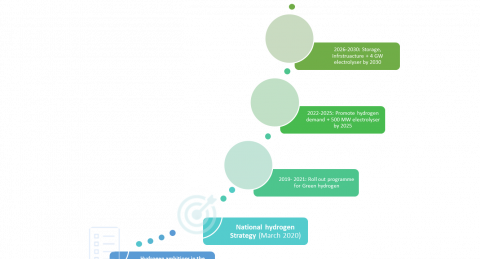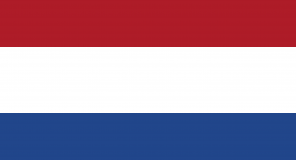Netherlands
Green hydrogen vision
According to the Dutch National Climate Agreement, green hydrogen is envisaged as an indispensable gas to the national energy system. Netherlands was the earliest country to define hydrogen as a clean fuel in its climate ambitions and as a result of this unique starting position of the country in the green hydrogen space as a trading hub, it aims to integrate it in the decarbonization of the transport, agriculture, and urban sectors.
The government’s national strategy is expected to lead to the creation of new jobs, improvements to air quality and, moreover, is crucial to the energy transition. The government focuses on three key areas in its strategy to realise the opportunities of green hydrogen – upscaling, cost reduction and innovation.
“The Netherlands has the ambition to become a European leader in the deployment of hydrogen, as hydrogen is considered to play an essential role in the transition, to achieve the 2050 climate goals” (Fuel Cells and Hydrogen Joint Undertaking, European Union)
National Strategy
The Dutch government set out its hydrogen ambitions in the Dutch Climate Agreement in June 2019, following which it released it National Hydrogen Strategy in March 2020. The strategy primarily focuses on developing the hydrogen infrastructure, unlocking supply channels, cross-sector cooperation and facilitating green hydrogen projects.
The strategy is split into three major phases:
-
2019-2021: Roll out programme for current green hydrogen projects.
-
2022-2025: Develop the demand for green hydrogen and regional infrastructure. Scaling up installed electrolyser capacity to 500 MW by 2025
-
2026-2030: Massive scaling up of electrolyser capacity to 4GW by 2030, and expansion of storage and infrastructure.
The strategy is based on following 4 areas:
-
Legislation & Regulation: The strategy envisages to use existing gas grid for hydrogen transport and market regulation. The regional network operators and network companies will be involved in this process of reviewing whether and under which conditions part of the gas grid can be used for the transport and distribution of hydrogen. The connections with and in Germany are identified the potential demand and supply, especially the Port of Rotterdam.
-
Cost Reduction & Scaling up Hydrogen: The strategy foresees linking hydrogen production to offshore wind energy (possible combined tenders), introducing a blending obligation and establishing support schemes for research, scaling up and rolling out of project plans. The support scheme includes a new subsidy of €35million per year in addition to the existing €40million Demonstration Energy and Climate Innovation (DEI+) scheme.
-
Sustainability of Final Consumption: The strategy aims to encourage the use of green hydrogen in ports and industry clusters, transportation and electricity systems and the agricultural sector.
-
Supporting and Flanking Policy: Through the strategy, the government will promote international collaboration, contribute to regional policy frameworks and promote research and innovation.
In addition, the Dutch Ministry of Economic Affairs and Climate Policy, TenneT and Gasunie ran a study in 2021 on the development of a national hydrogen infrastructure called HyWway27. The study highlights the possibility to use the existing natural gas network to transport hydrogen.

Capacity and capacity targets
-
The national hydrogen strategy from March 2020 aimed at having an electrolyser capacity of 500 MW by 2025 and a target of 4GW by 2030. The current electrolysis capacity of the Netherlands is 3 MW (according to IPHE by November 2021).
Impact Targets
-
The Netherlands aims at reducing CO2 emissions by 49% by 2030 and 95% by 2050. On achieving the green hydrogen targets, it is estimated that 0.9 - 3.2 Mt CO2 emissions can be avoided annually by 2030 , along with 4.3-14.3 TWh per year of avoided fossil fuel imports .
-
The green hydrogen value chain is estimated to create between 5110 and 18,200 new jobs by 2030 .
Policy Spotlight
-
Electrolyser subsidy: According to an independent research by Energy Monitor, the Netherlands has the highest subsidies per gigawatt of electrolyser capacity committed in the world – €1.43 billion in total2.
-
Hydrogen injection in gas distribution: According to the ministerial decree on gas quality (Regeling Gaskwaliteit), the Dutch legal framework allows hydrogen injection up to 0.5% in regional gas distribution systems. The government is also considering the possibility of mandatory injection of green hydrogen (physically or through certificates) to create a demand for green hydrogen.
-
Introducing carbon pricing: The Netherlands plans to set up a CO2 pricing mechanism and has introduced carbon emissions taxation for vehicles, which is key to progressively shift towards the use of low carbon emitting vehicles.
-
Green Deal “H2-Wijken”: The central government, regional governments, and market parties have agreed a Green Deal to work together on the technical, legal, and social aspects of hydrogen use in residential heating.
Project Spotlight
- On 4 October 2024, His Majesty King Willem-Alexander of the Netherlands officially inaugurated a new electrolyser for producing green hydrogen near Utrecht. Built by Hysolar, this facility is situated at the KWR Water Research Institute in Nieuwegein and was established through the LIFE NEW HYTS project, which received funding from the LIFE Programme. This advanced facility marks a significant advancement in green hydrogen production and its contributions to the energy transition. Green hydrogen is essential for achieving a CO2-neutral future, offering sustainable alternatives for transportation, machinery, and various industrial sectors. The new electrolyser in Nieuwegein will generate 300,000 kg of green hydrogen every year—sufficient to fuel around sixty buses or trucks. This positions Nieuwegein as one of the Netherlands' leading sites for green hydrogen production, further enhancing the country's role in sustainable energy innovation.
- RWE, the largest electricity producer in the Netherlands, has recently secured the construction and environmental permits needed to build a 100-megawatt (MW) electrolyser near the Magnum power plant in Eemshaven, located in the northern region of the country. This initiative is part of the company’s strategy to advance green hydrogen production and enhance integration within the nation's energy system. The electrolyser will convert renewable electricity from the OranjeWind wind farm, a 795 MW offshore project in the North Sea, developed in collaboration with TotalEnergies.
- In September 2024, Shell and TenneT reached a connection and transport agreement that will integrate the first large-scale hydrogen plant into the high-voltage grid. Shell’s Holland Hydrogen 1 will feature a 200-megawatt (MW) electrolyser located on the Maasvlakte. Initially, the electrolyser will be temporarily connected to the 380 kV high-voltage substation at Maasvlakte. Once the new Amaliahaven 380 kV high-voltage substation is completed, Shell will permanently connect to the high-voltage network. This agreement enables TenneT to fulfil Shell’s timeline requirements for the connection.
Financing
-
In the €1.35 billion National Growth Fund that was announced in April 2021, €338 million has been allocated to finance the production of green hydrogen projects.
-
€3.6 million is allocated for the first offshore green hydrogen production pilot in the Netherlands .
-
The government has announced a €1.07 billion grant for investments in green hydrogen in 2022.
-
According to government's own calculations, the scaling up of green hydrogen production capacity to 3 to 4 GW by 2030 will require € 5 billion.
